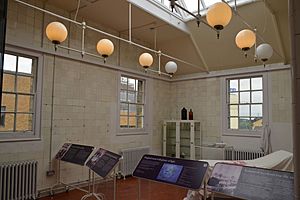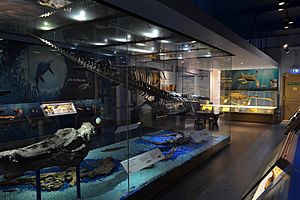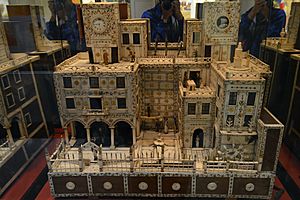Peterborough Museum and Art Gallery facts for kids
The Peterborough Museum and Art Gallery is a super cool place in Peterborough, England. It's full of amazing historical items and beautiful art. You can explore the city's past and see incredible artworks all in one spot! Vivacity, a group that also runs local theatres and libraries, helps manage the museum.
Contents
Discovering the Museum's History
The building where the museum is located has a long and interesting story. It started as a private home way back in 1816. Some parts of its cellar are even older, from a house built in the 1500s! Imagine living in a house that old.
From Home to Hospital
In 1856, a rich person called Earl Fitzwilliam bought the big house. He let it be used as Peterborough's very first hospital! It helped people from 1857 until a new hospital opened in 1928.
Becoming a Museum
Later, in 1931, a kind person named Sir Percy Malcolm Stewart bought the building. He gave it to a local society so it could become a museum. This was a big step for preserving Peterborough's history! An art gallery was added in 1939, making it even more exciting.
Who Manages the Museum Today?
Since 2010, the museum has been looked after by Vivacity. This is a special group that doesn't make a profit. They work to make sure the museum, along with places like the Key Theatre and city libraries, is great for everyone.
Amazing Collections to Explore
The Peterborough Museum has a huge collection of over 227,000 objects! These items tell the story of the area, from ancient times to more recent history. You'll find things that are truly unique and fascinating.
Ancient Wonders and Fossils
One of the coolest parts is the collection of local archaeology. You can see pottery made by the Romans who lived here long ago. There are also incredible marine fossils from the Jurassic period. These fossils are super important and show what life was like millions of years ago!
Stories of People and Art
The museum also keeps the original writings of John Clare. He was a famous poet known as the "Northamptonshire Peasant Poet." You can also see items made by French prisoners of war. These prisoners were held at Norman Cross Prison from 1797 to 1814. This was the world's first prison built just for war prisoners!
The art collection is also fantastic. It has many paintings, prints, and drawings. These artworks date from the 1600s all the way to today. You can see how art has changed over hundreds of years.
See also






